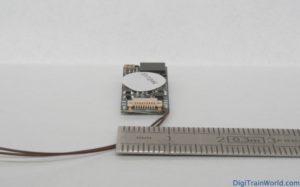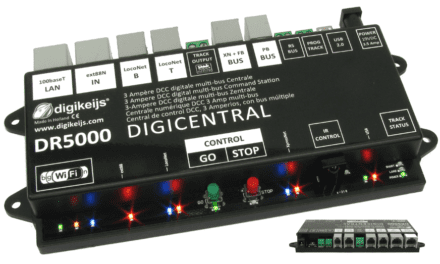A detailed review of the Next18 (NEM662) interface. Does it deserve to be NEM651’s successor?
Plux12? Not so much…
My article complaining about the multiplication of new digital interfaces in N scale model trains in Europe has had quite a lot of success (“DCC plugs overview (they’ve gone crazy)”). My criticism stays intact: European manufacturers need to stop meeting in closed rooms and inventing multiple interfaces to replace the NEM651, thereby segmenting the market.
That said, there is one fact I don’t argue. The NEM651 digital interface is old, does not offer enough possibilities, and needs a replacement.
In my original post, I thought the Plux12 interface was a nice compromise. After trying this interface on a Piko railcar, I realized the Plux12 was not so good. The good old pins (placed vertically) require a lot of vertical room in an N scale train:
Meet Next18
I recently decided to try out the Next18 interface (also called “NEM662”), which I originally criticised.
What changed my mind? Some manufacturers (in my case, Doehler & Haass) have released adapter boards for this interface, which means you can equip old models with the Next18 interface, and then just plug in a compatible decoder. Installing an interface, instead of soldering the decoder, is a good future proof strategy. Of course, this is all manual DCC conversion work.
There are also some store-bought models with the Next18 interface. Although, because of the segmentation, not all manufacturers are on board. One of these manufacturers is Liliput (now Bachmann Europe PLC).
Update 2014-07-29: Next18 is gaining traction. The German magazine Modellbahn Digital has announced that Arnold will start using the Next18 digital interface on its new models.
Update 2016-01-03: Next18 is conquering the UK. Graham Farish (Bachmann Europe Plc) is releasing its first Next18 models this year!
Specs
The Next18 interface boasts a good number of potential connectors in comparison with the old NEM651:
Of course, remember: the fact that an engine has a specific digital interface does NOT mean that all functions outputs are actually used and connected inside the engine. For example, Liliput trains already equipped with the Next18 interface do NOT use the full range of 6 auxiliary functions.
First impressions
“Testing” a DCC interface does not really make sense. So here are instead my first impressions, opening the box from the Doehler & Haass adapter boards for Next18, and the ESU Loksound Micro v.4 sound decoder in its Next18 declination.
The decoder is a sound decoder, so of course it is bigger than usual decoders. However, the Next18 does not seem to impact the overall size:
Once connected to the adapter boards, the vertical size remains reasonable. Actually lower than Plux12 pins:
This all seems very promising, and much smaller than what I had expected. I will be testing the interface by converting a train of my own.
One big drawback (customer confusion ahead!)
There is however one big issue with Next18: the NEM662 norm defines 2 interfaces:
- Next18 for decoders without sounds
- Next18-S for decoders with sound
In both cases, the Next18 plug/interface is exactly the same. However, the room to be left free for Next18-S decoders is bigger. Added to this, 2 pins are reserved to connect a loudspeaker with Next18-S.
It gets more complicated than that. A locomotive with a simple Next18 (no sound) interface will actually be able to accept a Next18 sound decoder, if the latter has adopted the smaller Next18 dimensions (which is the case for the CtElektronik SL76Next18). All you’ll have to do is connect the loudspeaker correctly.
Conclusion (for now)
Next18 may be the next best thing for European (and hopefully international) N scale models. It remains very small, but has plenty of connection options.
The Next18 vs. Next18-S possible confusion proves that German and Austrian train manufacturers still employ too many engineers and not enough marketing people (actually thinking about being “customer friendly”). That drawback, however, is not that serious.
I personally hope that more and more manufacturers will start selling their engines with the Next18 digital interface.
Reminder: I am a hobbyist and these articles only represent my personal views. I am not receiving any compensation, in any form, from the brands or stores mentioned here. The product names, marketing names, and brands mentioned here are the property of their respective owners.
This article was written with the N scale in mind
Although some of the content is relevant for other model railroading scales, if you are using another scale, additional or more accurate information might be available elsewhere!
External links
- The official NEM662 norm definition, only available from MOROP in French: http://www.morop.eu/fr/normes/nem662_f.pdf and in German: http://www.morop.eu/de/normes/nem662_d.pdf
- The adapter boards from Doehler & Haass if you want to equip old models with a Next18 interface. All models here in German: http://doehler-haass.de/cms/pages/produkte/soundsystem/anschlussadapter.php, also available EU-wide (for example) from Modellbahn-Shop lippe: http://www.modellbahnshop-lippe.com/produkt/Doehler%26Haass/128-4-0-222264-003003-0-0-0-0-2-0-grp-gb-h-0/ein_produkt.html
- The CtElektronik (Tran) SL76Next18 decoder. A Next18 sound decoder that actually fits in normal Next18 (non sound) plugs (in German): http://tran.at/Produkte/SL76Next18.shtml
- The Lokpilot Micro v4. One of numerous decoders now also available with a Next18 interface: http://www.esu.eu/en/products/lokpilot/lokpilot-micro-v40/














The Next-18S size (25mm x 10.5mm x 4.1mm) really competes with the Plu16 variant of the PluX family for size (20mm x 11mm x 4.2mm) and sound decoders are available in the Plu16 non-sound size (from Zimo with the MX648p16 for example). A shame really that the dimensions for Plu16S (28mm x 16mm x 6mm) were so generous and the Plu12S has not been properly defined by MOROP with a size.
Looks like Next18 variant sockets will haunt us like different versions of MTC-21 have in the larger scales. PluX is unfortunately a missed opportunity – it is the only connector with a high enough pin density for the features we are going to see going forward – sound with 6-functions is not an unreasonable provision to require and Plu16 is the only way to deliver it in ‘N’ and maintain compatibility with a range of decoders that can be used elsewhere.
All big disaster that will fragment the market. A nice after-market PluX socket would be nice too that is a little smaller than Zimo’s ADAPLU! That D&H NexT-18 socket is nice.
Thanks for the comment Suzie. You’re totally right. Having defined 2 Next18 decoder sizes was a mistake, especially because there is already a sound decoder in Next18 (non S) format anyway: the CtElektronik SL76Next18 http://www.tran.at/Produkte/SL76Next18.shtml and others will follow someday when costs go down further for smaller components. But the majority are available in the larger Next-18S size that rarely fits in N scale locomotives. Added to this the fact that the size of the space (S or non S) isn’t clear for inexperienced customers on the engine box or manual. All in all, that seems to be the same issue you are mentioning about Plu16S (which I didn’t know about).
I’m still more a fan of Next18 against the PluX family, especially as a N-scaler: the vertical pins on the PluX decoders are just a big waste of vertical space in small engines.
In any case, it’s all indeed a gigantic mess (as I mentioned here http://www.locgeek.com/2012/12/digital-plugs-yes-theyve-gone-crazy/ ), and the MOROP is not helping (basically making
a “norm” out of any new plug definition that the manufacturers send their way)…
I guess if you need to save the 1.3mm the NexT18 non-sound size may have some value (2.9mm compared to the PluX 4.2mm). I guess this is its only redeeming feature. It should not be an issue for manufacturers though where they have the opportunity to make the space at the design stage. In mitigation the pins on a PluX can go through the loco PCB if it is designed correctly where a 3mm saving on the pin length is gained.
The winner for me with PluX is having one pinout for all the sizes – if it fits in the socket it will work! Even if the space is not intended for sound, if the likes of Zimo come along and make a small sound decoder it will fit and work (without having to rewire the loco to make the speaker connection by disconnecting some functions – not a pleasant task if it involves PCB traces!)
I am beginning to think that MOROP believe you can’t have too many standards. NMRA are going the same way I think. Zimo are trying to kill MTC-21 by not making their low cost decoders available in that format and by not making any decoders for jst-9 so hopefully other manufacturers will follow and rationalise a bit on some of the legacy formats.
Keep up the good work.
Sound effects don’t worry me. I’ve yet to hear one that convinces me to spend the extra money. If anything, artificial sounds are childish. more suited to toys for a 4yo. Not a model railway.